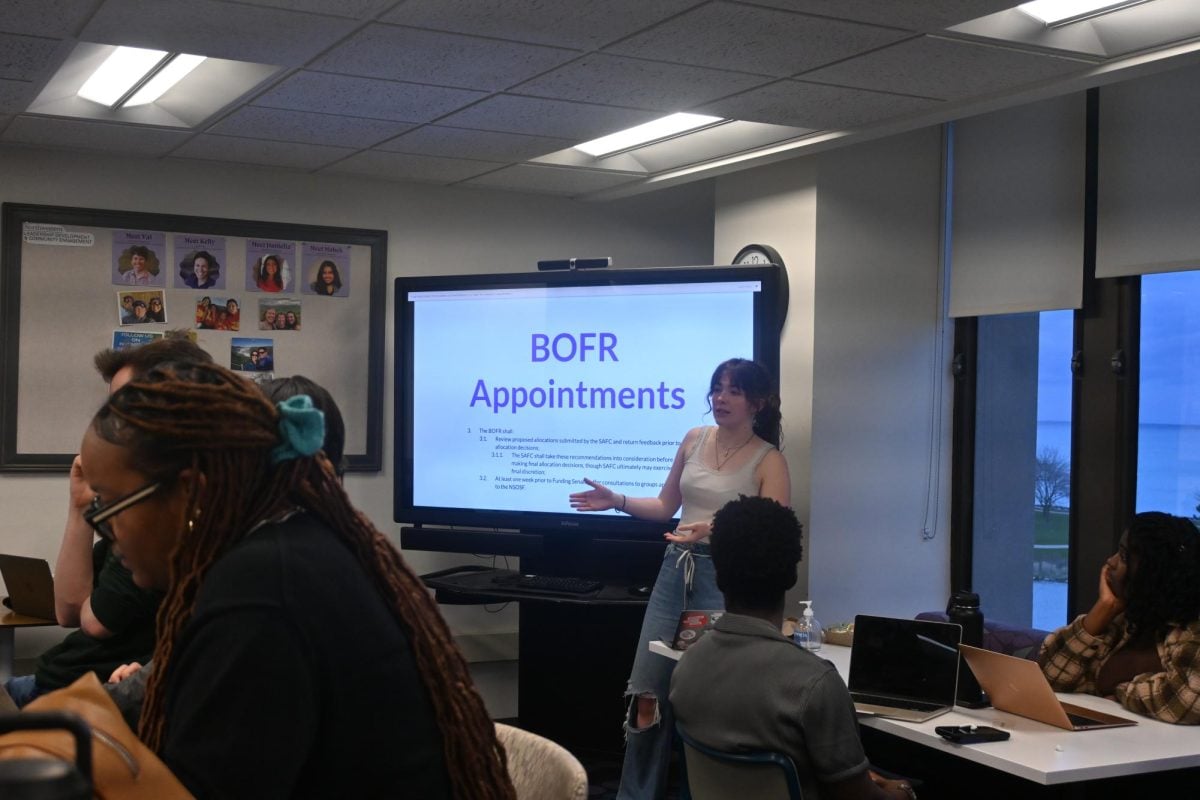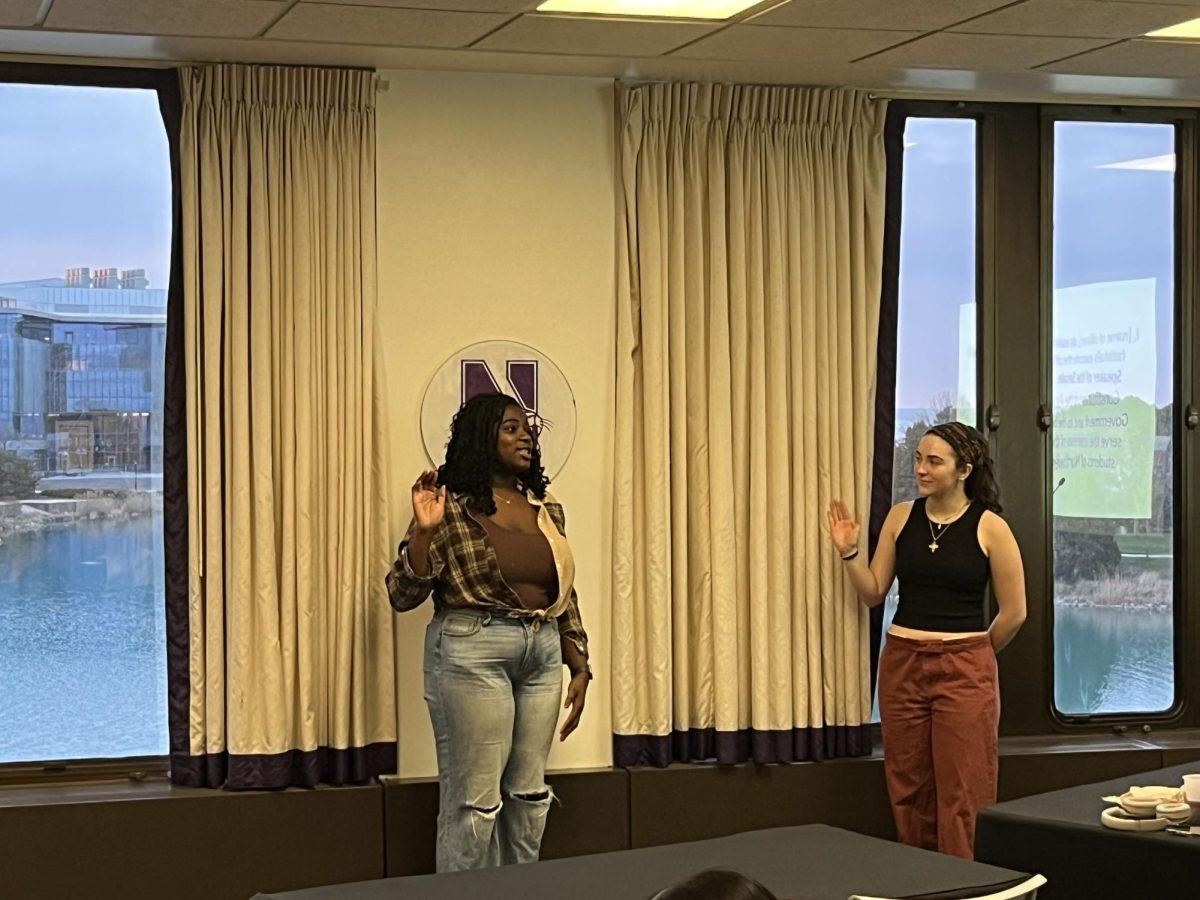In the past two months, Northwestern’s Associated Student Government has recruited new members, spoken with administrators and allocated $219,322 in funds. Its members have met with University and Evanston officials to discuss the controversial issues including the over-occupancy housing ordinance, student safety and crime.
But a lot of students say they simply don’t know how ASG has been spending its time.
“I think the most I’ve ever heard about ASG was welcome week freshman year,” said Ezra Olson, a Weinberg sophomore. “This quarter, maybe it’s just because I haven’t been paying attention, but I haven’t noticed or thought about ASG at all.”
Some senators say they also aren’t certain what’s been accomplished this fall, although they say there have been a lot of ideas and plans discussed.
“There has not been a lot of concrete progress this quarter,” said Augustine Santillan, a Weinberg freshman who won an ASG Senate seat this fall. “I honestly didn’t know what to think coming in … It’s interesting to see how it’s working out.”
Santillan, who represents North- and South- Mid Quads as well as Rogers House, communicates with his constituents mainly via the weekly emails that senators send out, but also through talking with students around him.
Weinberg freshman Allie Fredendall said she feels very conscious of ASG’s presence through her friendship with Santillan – but if she were not friends with a senator, she said, she likely would not know much about ASG. Fredendall said she could not name the current ASG president.
“If he (Santillan) wasn’t one of my close friends, I probably wouldn’t have any idea what ASG stood for and what it was about,” she said. “They should probably be a little bit more vocal about what they stand for and what they do.”
Administrators look to ASG to be “the eyes and the ears of the undergraduates,” according to University President Morton Schapiro, who has met with ASG multiple times each month since taking office in 2009.
He often directs students with concerns to their ASG senators, who he trusts to gather students’ opinions and present their priorities to the University.
“If the rest of the undergraduates realized how seriously the administration takes the leadership at ASG, they’d be more likely to vote,” he said. “I sure hope they (ASG) represent the rest of the students, because I certainly treat them as if they do.”
The lack of public knowledge about ASG’s various initiatives results in part from the way the group is operating this year, says ASG President Austin Young.
The Weinberg senior says part of ASG’s focus this fall has been developing projects, such as lighting or food quality improvements, rather than publicizing them.
“There’s a fine balance that ASG needs to reach and that we’re in the process of reaching, working on projects which take time and have developed from student interest and direct student feedback,” Young said. “There’s a lot of work that goes into these projects, and a lot of time, so (ASG is) having to balance working on preexisting projects with maintaining and developing relationships with students.”
‘If no one cares, what’s the point?’
One of those projects is the 5K Initiative. Based on a program in place at Yale University, NU’s 5K Initiative will offer $5,000 to a student with a plan to improve NU.
Past projects at Yale have included a DVD library and portable water fountains, but legislation presented in ASG senate Wednesday opens up the process to include any “common concern or idea for improvement … from more art on campus to a new sidewalk to a rental service of long boards.”
According to the legislation, idea submissions will begin at the start of Winter Quarter, and, after a selection committee determines the top several concepts, all undergraduates will be allowed to vote for their choice.
ASG hopes to select a project by the tenth week of the quarter; implementation of the plan would then be carried out the following quarter.
Young says he’s excited about ideas like these, which focus on community input and directly engage the student body, but some say they wonder if the implementation of these ideas has begun too late in the year.
“It’s already week seven or eight, and I think the excuse that we’re just kind of getting started, that we just put senate together – you can only use that excuse for so long before it becomes a little dated,” said Matt Bellassai, an RHA senator.
The Medill senior, whom the daily endorsed when he ran against Young in the election for ASG president last spring, said the lack of communication about ASG’s work is inexcusable for an organization meant to represent students’ needs and desires. He says he pledged to stay involved with ASG after the election in order to help achieve the “tangible, realistic goals” upon which he based his campaign, but that he’s been disappointed by the absence of clear direction.
“Since the time of the election, I haven’t really seen that from ASG,” he said. “And I’ve heard that from a lot of other people, that there’s sort of been a lack of prioritization of the issues that are really important to people.”
Part of the problem is student apathy, which ASG has battled for years, according to former president Claire Lew (SESP ‘11).
Lew says maintaining student interest is a natural struggle for an organization like ASG, which often works on a much more extended timetable than t
he four years most students spend on campus.
But Lew says another struggle ASG faces is organizing itself in a way that will best achieve its goals.
She addressed this issue last spring when she introduced legislation to restructure ASG Senate. Though the restructuring was never implemented, Lew said she hopes the message of the effort got through to students.
“(We were) really asking students to consider how we choose to represent ourselves,” she said. “Because at the end of the day, I don’t even know how many students know what Senate is, let alone care. And it’s like, if no one cares, what’s the point?”
Slow start
This fall, senator elections were delayed a week, and many of the new senators were write-in votes.
The difference of that week put ASG behind not only in its timetable of gathering ideas and creating plans, but also in its biggest fall responsibility: student group funding.
Jeremy Yablon, ASG’s financial vice president, said although the supplemental funding process began at the same time as usual, the new senators had one less meeting to prepare for the undertaking than their predecessors.
Another complicating factor was the position of vice president of public relations, which this spring remained vacant long after it is usually filled.
Medill senior Laurel Stankus said she wasn’t selected for the position until mid-summer, and had no formal powers until her selection was confirmed in October. Because of this, much of ASG’s typical Fall Quarter business – including new senator recruitment and communication with the student body – were much more difficult than usual.
Stankus, a newcomer to ASG, had little knowledge of the organization’s intricate framework, and she said she spent much of her first quarter on the executive board simply working to understand the infrastructure.
“The big learning curve for me was trying to figure out how each person worked to make ASG function as an institution and the importance of each person,” Stankus said. “Whether you’re a senator or a committee member, everybody serves a very specific function, that without it, ASG would not work.”
Communication between ASG and the student body has been frustrating for senators and students alike.
Bellassai, who served as VP of public relations before Stankus, said he thinks the delay in communication has served to alienate ASG – particularly in terms of leadership – from its constituents.
“I sort of equipped Laurel with my insights and the knowledge for being the PR VP, but if she wasn’t given the direction for what Austin and Ash (Jaidev, ASG vice president) wanted, she might not have been able to use what I gave her,” Bellassai said.
To an extent, Lew says, she agrees the delay in appointing Stankus put ASG at a disadvantage.
“That’s atrocious,” she said. “That should not have happened. I have no idea how that happened. There is no reason for that to have happened. And the fact that there was no accountability in terms of that process goes to show that there was clearly some sort of gap.”
Bridging the gap
Despite these hurdles, Young says ASG has made progress this quarter and plans to maintain its energy going into the rest of the year. He points to ideas that various senators and committees have worked on, including an initiative to reopen the doors of Deering Library and a Winter Quarter festival that will have similarities with Dillo Day, as evidence that ASG has been very busy this fall, despite whatever lapses in communication have occurred.
“I apologize for not communicating on a super regular basis,” he said. “We are definitely committed to doing that going forward, because we realize that there’s this disconnect from a lot of the projects we are working on and we have made progress on. We just haven’t been communicating that consistently. We don’t want people to feel like ASG’s not doing work, because they are.”
In an effort to increase communication between ASG and the student body, Stankus has made plans to reorganize the way the organization communicates. Winter Quarter tasks will include more meetings between ASG administration and students in “kitchen conversations” across campus, a dedicated social media person and a new website.
The website in particular has been of concern for Young, who said Vice President of Technology Ethan Romba has dedicated “hundreds of hours of behind-the-scenes, super thankless work” to creating a central hub where students can go to find information about ASG.
“There were thousands and thousands of unused pages and files and documents on the entire ASG server that hadn’t been updated or deleted for the last five years,” Young said. “We now have a very clean plate, a very fresh, awesome plate for the next site.”
Stankus said she also hopes to improve the ASG brand in the coming months so that students will know not only what ASG is but also what it does, from institutional changes like the new meal plan system to smaller projects like the reinstatement of the Norris University Center ice skating rink during winter quarter.
“My mission for this year is to try to help to have students know, this is ASG, and this is what ASG does, and this is something that ASG has done for you,” she said.







